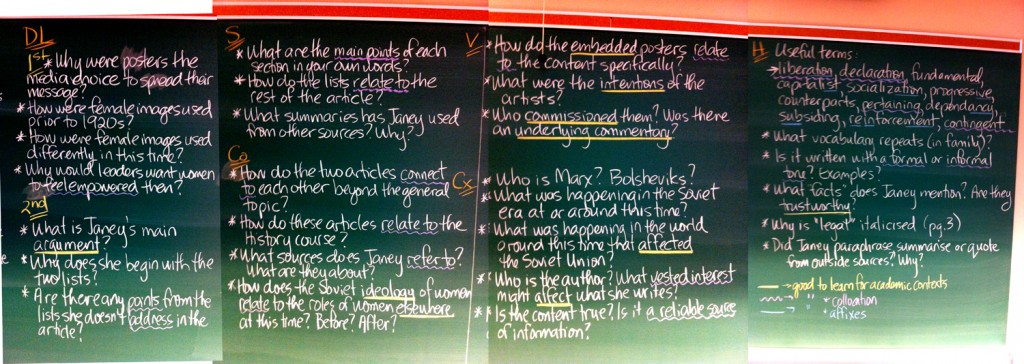EDIT: This is the first ever appearance of Academic Reading Circles online. Some information, including roles, have been since update in the book. Click here to see. If you use any information from this post, related ARC posts linked below, slideshares, or the book itself, please attribute it to Tyson Seburn, with a link to the related post, presentation, or book. Thank you!
A post ago, I showed the theory behind an academic adaptation to the model of literature circles, with a couple of handouts and videos thrown in there. A handful of teachers delighted me with their ‘successful’ subsequent uses , so I thought it might be useful (and fun) to show a practical example of my week’s Academic Reading Circle (ARC) with students not yet adept at the roles.
![]()
When I introduce the roles for the first time, I always bring in examples of each role based on a reading we’ve already done, and ask students to determine their value to the reading. For instance, the History course content was about Champlain. I brought in:
a) a related article about a museum that wanted funding from the government to conduct further study about the “Spitfire”, a warship from the American Revolution sunk at the bottom of Lake Champlain.
b) a timeline of Champlain’s life
c) information about the main characters of the article (e.g. the museum director, the battle of Valcour, the Spitfire, Benedict Arnold, etc.)
Through their discussion, we discovered together how useful the article was for connections to the History content (i.e. it introduces the importance of Lake Champlain as an historical setting), the timeline for placing items in chronological order and which characters of in the article were worth investigating for further understanding. Based on the number of ooohs and ahhhs and nodding heads, you can get lulled into a false sense that learners will think as critically on their own.
What you’ll probably find though through their first few tries at ARC roles on their own is that the role sheets (handout) act as a basic guide for learners, but they’ll bring in the most obvious visuals (or even ones “sourced from Google”), very general contexts (e.g. author occupation, facts about a country, etc) or weak connections (e.g. a randomly related article, connections to home country just from prior knowledge, etc). What happened to the conceptual understanding behind the ooohs and ahhhs from when you did it together? As usual, learners require more guidance to increasingly prepare them for autonomy. With this in mind, in our third ARC I decided to look a bit more closely at three of the roles in particular this week: Contextualiser, Connector and Visualiser.
![]()
Our History topic for the week was Susan B. Anthony and the role of feminism in suffrage. For the extended reading on this topic, I assigned two articles on Soviet propoganda of women from the early 20th century on Wednesday, November 9 (Week 8):
1) Emancipated Woman – Build Up Socialism! – an article written by a museum for an online exhibition on Women, Power and Politics; and
2) The Limits of Liberation; The ideals and realities of early Soviet family policy – a blog post written by an individual interested in Russia
You can download both here as PDF. By Monday, November 14, learners had chosen the roles for themselves and indicated so on this spreadsheet. This allowed me to focus on the learners in each group who assigned themselves these three roles.
Though I didn’t make a point of explaining this to learners (still the aim is to give them the freedom to think themselves), embedded in both are visuals of the propaganda itself. Context of the blog post author can be found by clicking on the about links on the website/blog and connections can be made between the two articles. However, at the beginning of the in-class discussion, I elicited what made this week’s materials different than previous weeks, at which was exclaimed that there were two articles instead of one and that visuals were included. Bingo! (at least one point was noticed)
![]()
On Wednesday, November 16, groups came together for the in-class discussion. As I have done each week to help fill in gaps in preparation, I put guiding questions on the board for each role for groups to use in conjunction with the preparation they’d already completed. In this case, my board looked like this (click to enlarge):
You’ll notice that aside from the Discussion Leader questions, the remainder of the guiding questions are about only the 2nd article (blog post) as I have continued to increasingly focus help on smaller and smaller sections. The aim is to still give students points to think about as if I had done the roles myself, but allow them more and more text to apply this help to autonomously.
Specific noteworthy points for the three roles, inherently helped by these two articles:
a. Visualiser – learners tend to suggest that the source of their photos is Google. I’ve pushed them to recognise that Google is just a search engine and that they need to click through to find the original source. Their embedding achieves this in part, but I still push to find the original source. Similarly, once discovered, can they determine if those photos are reliable, accurate and actually depicting content from the article. On top of that, they need the push to explain how their visual helps comprehension of the articles. In this context, I wanted learners to think about how the embedded propaganda posters related to the content of the article and beyond that, to think about who drew them and why they were used.
b. Contextualiser – in this case, the author of the blog post gives an excellent explanation as to her vested interest in Russia as a topic and ‘expertise’ in this area. Additionally, these two articles beg for discussion on reliability, especially with regards to the dates, stats and “facts” mentioned, but not referenced. Learners have particular difficulty with understanding how these and scholarly articles differ in terms of reliability. By talking about the process scholarly articles go through, it was easier for them to grasp that although the information in the articles may in fact be true (my blog posts are all true after all!), nothing has gone through the least bit of scrutiny by other experts.
c. Connector – I usually encourage students to do outside reading with regards to the topic in order to make connections. In this week’s case, the obvious connection to discuss here is that between the two articles. A good point to make is the angle at which the museum article talks about this propaganda (artistic) compared to that of the blog post (message relating to ideals of the time) and why this is naturally so.
You might also notice the use of colour coding and symbols in my boardwork. I took the opportunity of a recent shipment of coloured chalk to draw the Highlighter‘s attention to features of vocabulary we’d been studying elsewhere–affixes, collocation and key words. I’ve been making a concerted effort to include these in my oral and written instructions and making a point of it so learners develop the skill of noticing and transferring skills from one class to another.
The main idea behind the way I organised this ARC was to demonstrate the role of instructor-guided help for students in improving their understanding and expectations of each role. Giving students complete control over their roles from the get-go has proven to me that although it opens up discussion about a text much more than simple Q&A, they need more guidance towards better interaction with a given text. Otherwise, learners often aimlessly discuss points that aren’t that relevant. In my experience, it’s never too late to give them this help to varying degrees, even if complete control was initially given. We all make mistakes.
![]()
The following Friday, November 18, I asked for students to email their reflections of the in-class discussion. A couple standouts include:
“Our ability of critical thinking had improved a lot after few role’s practice as the board work guides us how to analyze article in a right way. At the beginning, I had no ideas about how to deal with my role and the boardwork really gave me some good advice on what I should do and which aspect I still did not mention yet…” (Student A, Mandarin speaker, female)
“…I learned something from this week is that it is important to find all different kinds of information to help you understand the article, but it is not enough. To find out why they did these things and the underlying commentary of the article is what I should be cared next time.” (Student B, Mandarin speaker, female)
I haven’t yet received the written reports for this week (due Wednesday, November 23), but I’ve encouraged learners to consider how to combine their preparation, the in-class discussion ideas and answers to my guiding questions for each of their roles.
I hope this rundown of one week’s ARC gives those who try it out a bit more guidance.
![]()
Wednesday, November 9 – Assign 2 articles
Monday, November 14 – Learners indicate chosen roles
Wednesday, November 16 – In-class ARC discussion
Friday, November 18 – Email reflection of in-class ARC
Wednesday, November 23 – Submit written report of ARC



Wow, Ty. Very impressed with the planning and detail that went into this lesson. Nice to see that one of their reflections was that “critical thinking” had been honed.
Seeing the spreadsheet, I’ve noticed for the first time that a number of the students have chinese names. Would love to chat with you sometime about our respective experiences.
Thanks Brad. 95% of my students hail from mainland China in fact. There are a couple Russians and a Korean in there too, but y’know.
I love what you’ve done with the reading circles – now I wish I were teaching reading this semester!
Thanks, Ellen. I’ve fallen in love with reading circles this year. I’m basing my first MA assignment on them even, but at the end of last year as a starting point for figuring out why they didn’t work and seeing if the modifications made this year are the same as I’d come to after some research. If it’s any consolation, I wish you were teaching reading too (but not in place of me).
I would like to provide the journals with critiques on literatrure
I would like to write critiques on litature, specially dramas written in 19th century by English, Norbegian and Russian playwrights. I find the early 19th/20th century dramas are attempts made by playwrights to interpret the simple tradition of the Greek drama
Very challenging, I’m sure, Newton.
[…] 3. Tyson Seburn: ARC in practicum […]
[…] ARC in practicum […]
[…] ARC in practicum, a concrete example of how this activity worked in reality. The interactions of ARC, which details interactions with instructor and each other. The highlighter role, details of how this lexically-focussed role works Context is important, a preview the Contextualiser role Using visuals to represent concepts in texts, introducing the Visualiser role to students Tagged with: ARC • critical reading • EAP • Reading • workshops Feel free to share this post! =) Cancel Reply […]
[…] appearance of ARC ever🙋🏽♀️ The interactions in ARC🙋 ARC in practicum🤚🏿ARC: Context is everything✋🏻 The evolution of […]